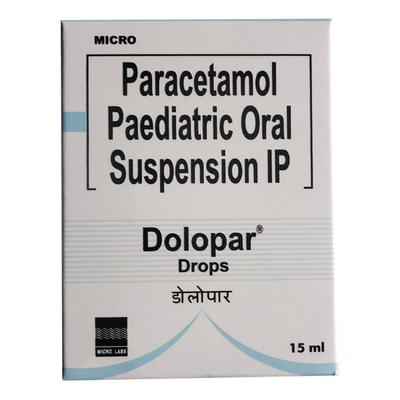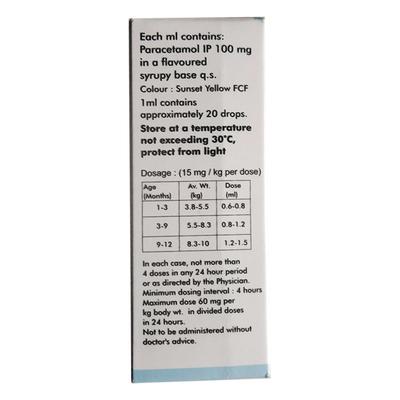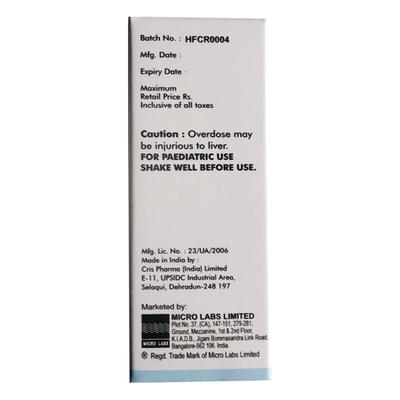

Netmeds First Membership
Quick Links
Introduction About DOLOPAR DROPS
Dolopar Drops belongs to analgesics and antipyretics used to manage fever, toothache, ear ache, headache, migraine, muscle ache, sore throat, musculoskeletal pain, fever and pain after vaccination. It contains Paracetamol as an active ingredient.
Paracetamol acts as an analgesic and antipyretic, which works by inhibiting the production of a chemical called prostaglandins which are responsible for pain and fever.
Always give Dolopar Drops to your child as advised by the physician. It is for paediatric use. Shake the bottle well before use. Your doctor will decide the correct dose and duration for your child depending upon age, body weight and disease condition. Do not give more than 4 doses within 24-hour period or as directed by the physician.
Key Composition
- Paracetamol
Therapeutic Uses Of DOLOPAR DROPS
- Fever
- Toothache
- Ear ache
- Headache
- Migraine
- Muscle ache
- Sore throat
- Musculoskeletal pain
- Fever and pain after vaccination
Side Effects Of DOLOPAR DROPS
Consult your doctor if you notice any unusual side effects in your child while using Dolopar Drops.
Safety Advice
- Always give Dolopar Drops to your child as advised by the physician.
- For 1-3 months baby give 0.6 to 0.8ml, for 3-9 months baby give 0.8 to 1.2ml, for 9-12 baby months give 1.2 to 1.5ml or as directed by the physician.
- Do not exceed the recommended daily dose as it may cause harm to the liver.
- It is for paediatric use. Shake the bottle well before use. Measure the appropriate amount of medicine in dropper. Drop directly onto your child’s tongue or mix with a little juice or water first. This dose may be repeated every 4 hours, if necessary (up to a maximum of four doses in any 24-hour period). Rinse the dropper with hot water before and after use.
- Do not give more frequently than every 4 hours.
- Do not give of your child is allergic to any of its ingredients.
- It is not recommended for use in patients with severe and active liver disease.
- Dolopar Drops should be used with caution in patients with kidney or liver problems.
- Tell your physician if you have recently taken any other medicines, including medicines obtained without a prescription, vitamin supplement or herbal products.
More Information
- Keep out of reach of children.
- Store below 30°C, protect from light.
FAQs About DOLOPAR DROPS
Q: What is the use of Dolopar Drops?
A: Dolopar Drops belongs to analgesics and antipyretics used to manage fever, toothache, ear ache, headache, migraine, muscle ache, sore throat, musculoskeletal pain, fever and pain after vaccination,. It contains Paracetamol as an active ingredient.
Q: What happens I take more Dolopar Drops?
A: Taking Dolopar Drops more than daily dose may cause serious liver damage, acute pancreatitis has been observed, usually with liver dysfunction and liver toxicity.
Q: How does Dolopar Drops works?
A: Paracetamol acts as an analgesic and antipyretic, which works by inhibiting the production of a chemical prostaglandins which are responsible for pain and fever.
Q: Is Dolopar Drops safe in children?
A: Dolopar Drops is safe to take in recommended doses. Do not give more than 4 doses within any 24-hour period and do not give more frequently than 4 hours. Overdose may be injurious to liver.
Q: What to do if fever continues even after taking Dolopar Drops?
A: Consult your doctor for medical advice if fever persists even after taking Dolopar Drops. This is to ensure that fever associated with any serious infection is quickly diagnosed.
Q: What are the side effects of Dolopar Drops?
A: There are no side effects reported with the use of Dolopar Drops. However, consult your doctor if you notice any unusual side effects in your child while using Dolopar Drops.
References
1. http://www.microlabsltd.com/elibrary/node/1805
2. https://calpol.com.ph/products/calpol-infant-drops/
3. https://www.crocin.com/crocin-products-for-children/crocin-drops-for-children/
4. https://go.drugbank.com/drugs/DB00316
5. https://india-pharma.gsk.com/media/6355/calpol-tablets-oral-suspension-and-paediatric-drops.pdf









